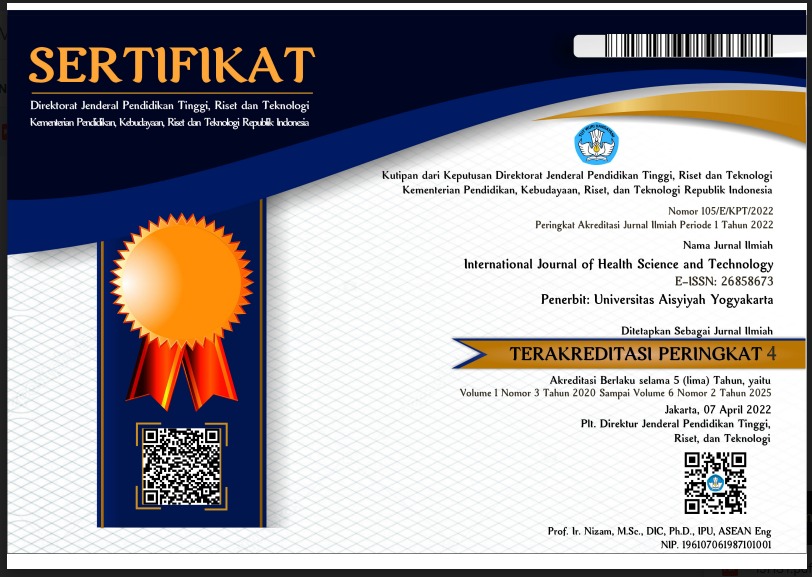WhatsApp group increase antenatal visit
DOI:
https://doi.org/10.31101/ijhst.v2i1.1817Abstract views 873 times
Keywords:
health promotion, whatsapp groupAbstract
References
Agus, Y., & Horiuchi, S. (2012). Factors influencing the use of antenatal care in rural West Sumatra, Indonesia. BMC pregnancy and childbirth, 12(1), 9.
Budiman, R. A., Juhaeriah, J., & Gina, H. (2010). Faktoribu yang berhubungandenganberatbadanbayilahir di Puskesmas Garuda Tahun 2010. Jurnal Kesehatan Kartika, 1, 1-12.
Campbell, O. M., Graham, W. J., & group, L. M. S. S. s. (2006). Strategies for reducing maternal mortality: getting on with what works. The Lancet, 368(9543), 1284-1299.
Carroli, G., Rooney, C., &Villar, J. (2001). How effective is antenatal care in preventing maternal mortality and serious morbidity? An overview of the evidence. Paediatric and perinatal Epidemiology, 15(s1), 1-42.
DinKesKotaYogyakarta. (2015). Profil Kesehatan Kota Yogyakarta. Retrieved from Yogyakarta
DinKes Kota Yogyakarta. (2017). Profil Kesehatan Kota Yogyakarta. Retrieved from Yogyakarta:
Ellanti, P., Moriarty, A., Coughlan, F., & McCarthy, T. (2017). The use of Whatsapp smartphone messaging improves communication efficiency within an orthopaedic surgery team. Cureus, 9(2).
Free, C., Phillips, G., Galli, L., Watson, L., Felix, L., Edwards, P. Haines, A. (2013). The effectiveness of mobile-health technology-based health behaviour change or disease management interventions for health care consumers: a stematic review. PLoS medicine, 10(1), e1001362.
Howitt, P., Darzi, A., Yang, G.-Z., Ashrafian, H., Atun, R., Barlow, J. Conteh, L. (2012). Technologies for global health. The Lancet, 380(9840), 507-535.
KemenKesRI. (2015). Kesehatan dalam kerangka Sustainable Development Goals (SDGs). Retrieved from Jakarta:
Khoramabadi, M., Dolatian, M., Hajian, S., Zamanian, M., Taheripanah, R., Sheikhan, Z., Seyedi-Moghadam, A. (2016). Effects of education based on health belief model on dietary behaviors of Iranian pregnant women. Global journal of health science, 8(2), 230.
Lori, J. R., Munro, M. L., Boyd, C. J., &Andreatta, P. (2012). Cell phones to collect pregnancy data from remote areas in Liberia. Journal of NursingScholarship, 44(3), 294-301.
Lund, S., Hemed, M., Nielsen, B. B., Said, A., Said, K., Makungu, M., &Rasch, V. (2012). Mobile phones as a health communication tool to improve skilled attendance at delivery in Zanzibar: a clusterâ€randomised controlled trial. BJOG: An International Journal of Obstetrics & Gynaecology, 119(10), 1256-1264.
Lund, S., Nielsen, B. B., Hemed, M., Boas, I. M., Said, A., Said, K., . . .Rasch, V. (2014). Mobile phones improve antenatal care attendance in Zanzibar: a cluster randomized controlled trial. BMC pregnancy and childbirth, 14(1), 29.
McNabb, M., Chukwu, E., Ojo, O., Shekhar, N., Gill, C. J., Salami, H., &Jega, F. (2015). Assessment of the quality of antenatal care services provided by health workers using a mobile phone decision support application in northern Nigeria: a pre/post-intervention study. PLOS one, 10(5), e0123940.
Medhanyie, A., Spigt, M., Dinant, G., & Blanco, R. (2012). Knowledge and performance of the Ethiopian health extension workers on antenatal and delivery care: a cross-sectional study. Human resources for health, 10(1), 44.
Montag, C., Kannen, C., Lachmann, B., Sariyska, R., Duke, É., Reuter, M., &Markowetz, A. (2015). The importance of analogue zeitgebers to reduce digital addictive tendencies in the 21st century. Addictive Behaviors Reports, 2, 23-27.
Notoatmodjo, S. (2007). Promosi kesehatan dan ilmu perilaku. Jakarta: Rineka Cipta, 20.
Oyeyemi, S. O., & Wynn, R. (2014). Giving cell phones to pregnant women and improving services may increase primary health facility utilization: a case–control study of a Nigerian project. Reproductive health, 11(1), 8.
Oyeyemi, S. O., & Wynn, R. (2015). The use of cell phones and radio communication systems to reduce delays in getting help for pregnant women in low-and middle-income countries: a scoping review. Global health action, 8.
Sharma, S., Van Teijlingen, E., Belizán, J. M., Hundley, V., Simkhada, P., &Sicuri, E. (2016). Measuring What Works: An impact evaluation ofwomen’s groups on maternal health uptake in rural Nepal. PloS one, 11(5), e0155144.
Downloads
Published
How to Cite
Issue
Section
License
International Journal of Health Science and Technology allows readers to read, download, copy, distribute, print, search, or link to its articles' full texts and allows readers to use them for any other lawful purpose. The journal allows the author(s) to hold the copyright without restrictions. Finally, the journal allows the author(s) to retain publishing rights without restrictions
- Authors are allowed to archive their submitted article in an open access repository
- Authors are allowed to archive the final published article in an open access repository with an acknowledgment of its initial publication in this journal

This work is licensed under a Creative Commons Attribution-ShareAlike 4.0 Generic License.










